Meadow Bindweed
Meadow Bindweed is a member of the Morning Glory or Convolvulaceae family and contains poisonous alkaloids including pseudotropine. It can be a real problem for other plants as it can outgrow most of them and takes all the nutrients, sunlight and water for itself.
| Hedgerow Type | |
| Common Names | Meadow Bindweed, Field Bindweed, Creeping Jenny |
| Scientific Name | Convolvulus arvensis |
| Season Start | Jan |
| Season End | Dec |
Leaves
The leaves are arrow shaped with pointed ‘tails’ arranged in a spiral along the creeping, sprawling, climbing stem.
Flowers
The flowers are either pink and white striped, pictured, or plain white and shallowly trumpet shaped.
Stem
Can have a very long sprawling stem that can cover quite a distance and climb almost any obstacle.
Possible Confusion
The leaves look similar to Common Sorrel, pictured, but Sorrel grows in a rosette with one leaf per stem, Meadow Bindweed grows in a tangled mass spreading over some distance with many leaves on a stem.
Frequency
Very Common.
Other Facts
This bindweed is a problem for arable farmers as it is so invasive and can outgrow most species. It is also a problem for livestock causing colic like symptoms if consumed by horses.

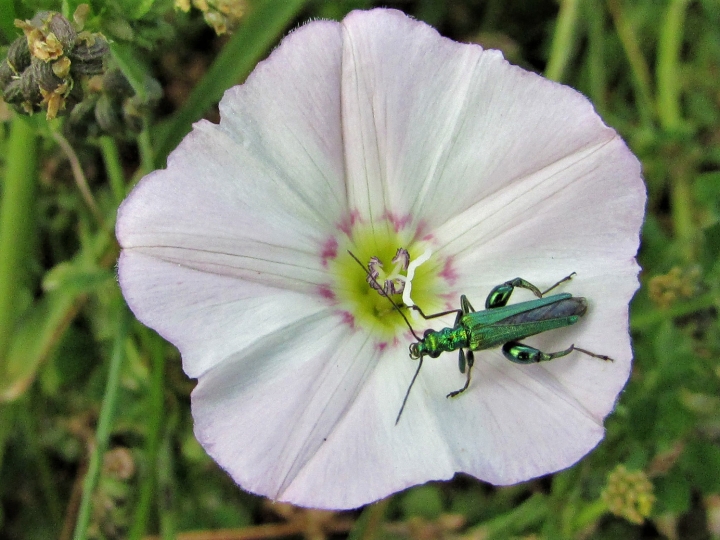
















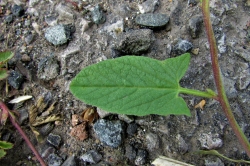
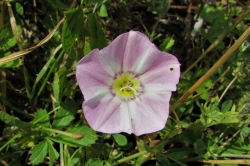
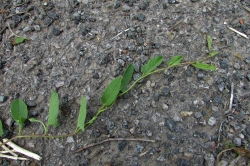
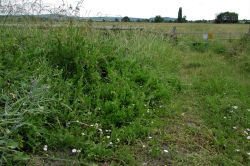
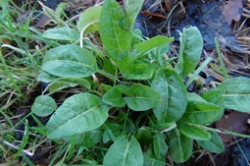





4 comments for Meadow Bindweed
We have bindweed in abundance. It seemed to arrive in compost bags some years ago!
Weed killer does not kill the weed neither does smothering. My cold frame has a solid impervious base and on clearing old medium there was the bindweed growing through the base . It is driving me up the wall.
A rose I bought the other year must have had this weed hidden in the roots as the area the rose is is full of the stuff.
HELP!!
The only way to kill bindweed is with glyphosate weed killer applied to the leaves as this will work its way down to the roots. Some glyphosates are now banned but I think some are still available in garden centres.
Please don’t use glysophate:
The World Health Organisation listed glyphosate as probably carcinogenic. Numerous other independent research studies have looked into the chemical’s negative impacts. These include damage to liver, kidney and skin cells, as well as disruption to soil and aquatic life.
Recently there have been a number of court cases in the US, where Monsanto (now owned by Bayer) have been found guilty of suppressing information on the toxicity of its glyphosate product, Roundup. The link with non-Hodgkin’s lymphoma is now undisputed. As one attorney put it, “Monsanto has never had any interest in finding out whether Roundup is safe. Instead of investing in sound science, they invested millions in attacking science that threatened their business agenda.”
Please don’t spread out of date and incomplete information about glyphosate.
The WHO have clarified their position, see https://www.chemistryworld.com/news/who-clarifies-glyphosate-risks/1010208.article
The US EPA stated that there was minimal risk if used correctly, see https://www.epa.gov/ingredients-used-pesticide-products/glyphosate
Independent studies agree e.g. https://academic.oup.com/jnci/article/110/5/509/4590280
The EU have just approved further use, see https://food.ec.europa.eu/plants/pesticides/approval-active-substances/renewal-approval/glyphosate_en
Bayer actually won the majority of the cases bought against them. The most famous US court case was one of the early ones which they lost: a groundskeeper who was using insanely high concentrations over a long period of time and with inappropriate safety equipment.
Labels on dangerous substances are there for a reason.